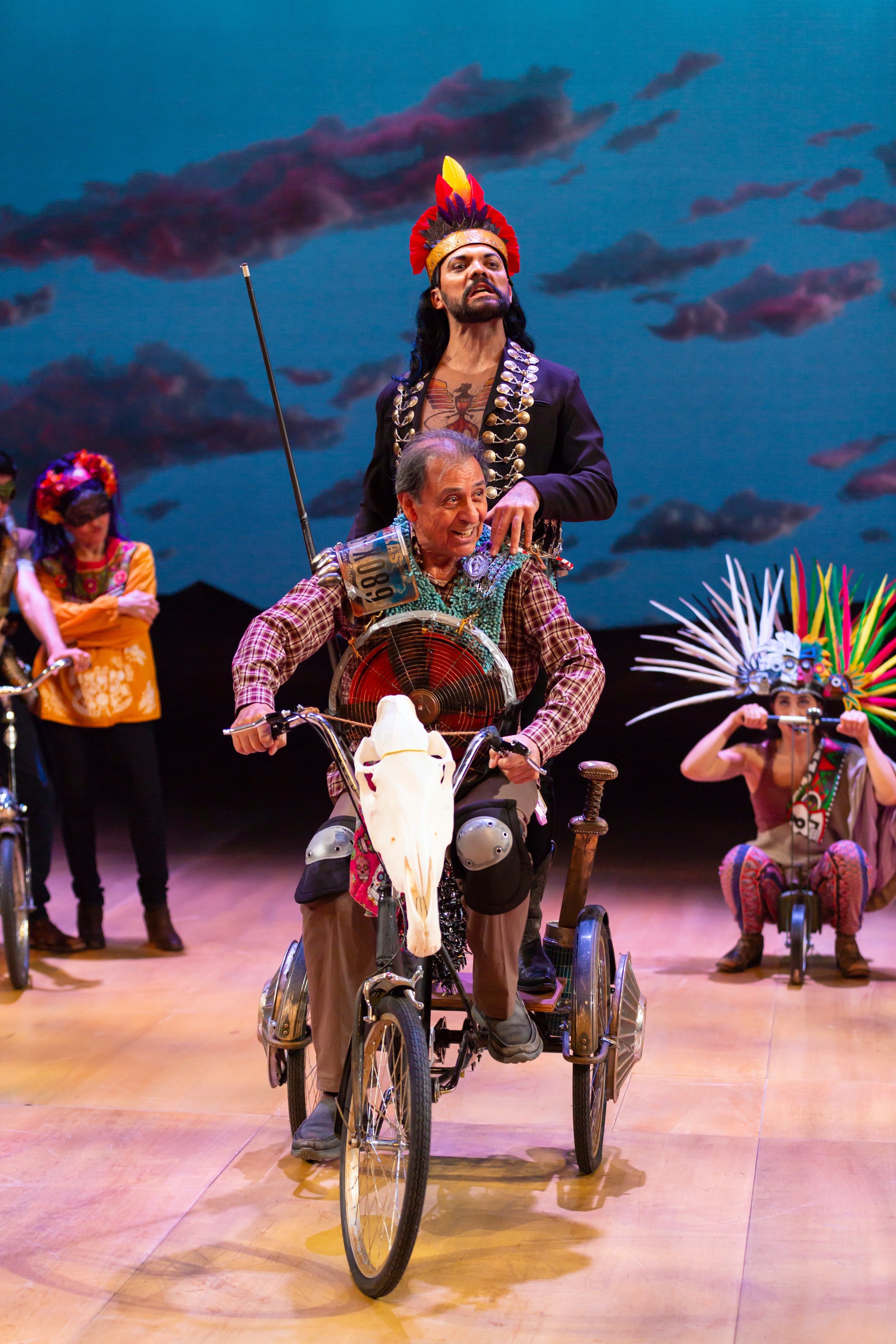Review of Quixote Nuevo, Hartford Stage
From the moment the “calacas” take the stage, in a display of eye-catching costumes by Rachel Healy that evoke the imagery of the North American southwest and the ancient culture of Mexico, Quixote Nuevo explodes with color and movement. In Octavio Solis’ heartfelt modern reimagining of Cervantes’ Don Quixote, directed with vitality and poetry by KJ Sanchez, the demonic troupe’s energy comes from the disturbed mind of Jose Quijano, played by veteran TV actor Emilio Delgado with charming pathos and humor. A timely comedy with true mythopoetic power, the show runs at Hartford Stage until October 13, following its world premiere at the California Shakespeare Festival last year.
Quijano’s delusions, as he takes to the road as a modern-day Quixote in search of his muse Dulcinea, are profoundly disturbing to others and vastly entertaining to the audience. The “others” include his sweetly diffident niece, Antonia (Gianna DiGregorio Rivera); his abrasive sister, Magdalena (Mariela López-Ponce); his well-meaning but timid priest, Padre Perez (Orlando Arriaga), and his earnestly out-of-her-element psychiatrist, Dr. Campos (Gisela Chipe). After seeing how ill-served Quijano, a retired literature professor losing his mind, is at home, we’re ready to ride off with him, as he takes to his adult-sized tricycle adorned with a horse’s skull, garbed in a pastiche of armor that includes a rotary fan as breastplate.
Jose Quijano/Don Quixote (Emilio Delgado), front; Papa Calaca (Hugo E. Carbajal), rear, with the cast of Quixote Nuevo at Hartford Stage (photos by T. Charles Erickson)
He soon enough finds his Sancho Panza in Manny Diaz, a vendor of paletas, played by Juan Manuel Amador with engaging comic nuance. And their first adventure is at a karaoke dive where many of the actors already introduced play slumming locals in an establishment run by Bruno Castillo (Ivan Jasso) and Rosario Castillo (Krystal Hernandez). Bruno graciously agrees to dub Quixote with a sacred relic: the trigger finger of Pancho Villa, a prop that will come back in Part 2 to hilarious effect thanks to Diaz. The remaining cast member is Hugo E. Carbajal who plays Papà Calaca—Death, in other words—with magnetic stage presence as a surprisingly simpatico wraith always hovering on the edge of Quijano’s awareness.
Manny Diaz/Sancho Panza (Juan Manuel Amador)
One of the great attributes of Cervantes’ classic tale of an aging Spanish landowner who believes he lives in a world of knights-errant and chivalry is how episodic it is. Quixote’s is a story of seemingly random encounters and the schema is easily adaptable by Solinas to a different series of adventures—such as an encounter with Cardenio (Arriaga), a grieving refugee in a mountainous region, or a battle with an overbearing border guard (Carbajal) and a joust with a surveillance balloon. The current and longstanding problems at the U.S. and Mexican border is key to the background ambiance of Solis’ play, and the device of Quixote chimes well with a felt need to find sustaining myths for our country and our times.
Jose Quijano/Don Quixote (Emilio Delgado), center, with the cast of Quixote Nuevo
The notion of a Tejano—a Mexican-American from Texas—as an American Everyman plays into our country’s fondness for myths about the West, even as the play finds a way both to inhabit the specific region and to take stock of the many tropes we already know so well. Solis’ jokes about Iron Man or Games of Thrones are tellingly apt. A latter day Quixote might believe he’s a Marvel superhero or living in one of the regions depicted in George R.R. Martin’s saga of warring houses. The point is that we’re always willing to enter a fantasy world, if only to suspend belief in the distressing times in which we live.
The weakest aspect of the play—tellingly—is the effort to people Quijano’s and Diaz’s village, La Plancha. The characters have little to sustain them beyond manner—whereas the people met on the road or in Quijano’s fantasies are suitably defined by the encounter. The play ends—after two and a half hours—somewhat abruptly, after evoking the challenge of a wall that may or may not exist. But then the end of any version of Quixote tends to be a compromise with dramatic necessity: the story must end somehow. Death is the end of delusion.
The music by David R. Molina and Eduardo Robledo lends much flavorful atmosphere as does Takeshi Kata’s chameleonic vista of sky and clouds, lit by Brian J. Lilienthal. If the changing colors and cloud consistencies on display doesn’t make you long for desert regions, you’re even more of a northeasterner than I am. The wide-open spaces of the set are graced when needed by a bar or miniaturized storefronts signaling distant streets. It’s a wonderfully imaginative use of the Hartford Stage’s amphitheater.
An entertaining epic on aging that looks at how the life of the mind—as a theater of consoling fictions—both sustains us and deceives us, Quixote Nuevo shows us, in the inspirations and confusions of its professor as paladin, the enduring humanitas of the humanities.
Jose Quijano (Emilio Delgado), Antonia (Gianna DiGregorio Rivera)
Quixote Nuevo
By Octavio Solis
Directed by KJ Sanchez
Scenic Design: Takeshi Kata; Costume Design: Rachel Healy; Lighting Design: Brian J. Lilienthal; Composer & Sound Design: David R. Molina; Co-Composer: Eduardo Robledo; Music Director: Jesse Sanchez; Fight Director: Ted Hewlett; Vocal & Dialect Coach: Robert Ramirez; Dramaturg: J. Sebastián Alberdi; Production Stage Manager: Rob Chikar; Assistant Stage Manager: Kasson Marroquin
Cast: Juan Manuel Amador; Orlando Arriaga; Hugo E. Carbajal; Gisela Chipe; Emilio Delgado; Krystal Hernandez; Ivan Jasso; Mariela López-Ponce; Gianna DiGregorio Rivera
Hartford Stage
September 19-October 13, 2019



